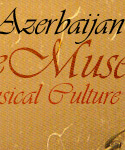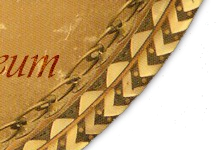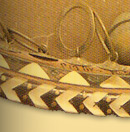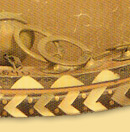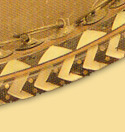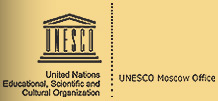|
International Symposium
Musical Instruments of the Turkic Speaking Nations
The symposium was organized by The Ministry of Culture and Tourism of the Republic of Azerbaijan, TURKSOY and State Museum of Musical Culture of Azerbaijan and took place in Baku on 16-17 December, 2010.
See PHOTO GALLERY
The main directions of the work of symposium were:
- Generals and specifics in musical instruments of Turkic speaking nations;
- Technology and acoustics of the musical instruments;
- Traditional musical instruments in composer’s works;
- Iconography of musical instruments;
- Collections of musical instruments of Turkic speaking nations;
- New approaches and estimations;
- Performing art;
- Restoration and preservation of disappeared and disappearing musical instruments;
- The problems of ethnoorganology and pedagogic.
The Programme of International Symposium
Musical Instruments of the Turkic Speaking Nations
The Opening ceremony
Speeches:
1. Abulfas GARAYEV – Minister of Culture and Tourism of the Republic of Azerbaijan
2. Dusen KASEINOV – General Secretary of TURKSOY
3. Alla BAYRAMOVA – Director of Azerbaijan State Museum of Musical Culture, Secretary of the symposium
Section 1: History and evolution of musical instruments
Chairmen of the section: Saadat ABDULLAYEVA (Azerbaijan), Raziya SULTANOVA (United Kingdom), Rana Mammadova (Azerbaijan), Jennifer Post (USA)
- Zemfira Safarova, Azerbaijan.
Explanation, restoration and evolution of musical instruments in the works of Safiaddin Urmavi ( XIII century)
- Suraya Aghayeva, Azerbaijan.
Turkic musical instruments and their exploration methods in the works by Abu Nasr Farabi (IX-X centuries) and Abdulgadir Maraghi (XIV-XV centuries)
- Genichi Tsuge, Japan.
Musical instruments described in the Kanz al-tuhaf (14th century) and their relationship to the modern Uygur instruments
- Gulnaz Abdullazade, Azerbaijan.
The instrument shahrud in the works of Al Farabi
- Lala Kazimova, Azerbaijan.
Musical instruments in Darvish Ali’s treatise (XVII century)
- Shehvar Beshiroghlu, Turkey.
Development of changi from tradition to modernity: structure, form, style and performing technique in Anatolia
- Jamila Gurbanova, Turkmenistan.
Evolution of turkmen musical instruments
- Gokchen Ilhami, Canada.
Description of the turkic musical instruments in Evliye Chelebi’s (1611-1682) “Sayahatname” treatise and H.C.Farmer’s book
- Giovanni de Zorzi, Italy.
The Ottoman Ney Flute: between Music and Metaphysics
- Gennady Makarov, Tatarstan, Russian Federation.
Medival musical ensembles of Tatars living along Volga river
- Oghuz Elbash, Turkey.
Ancient musical instruments of Anatolia
- Abbasgulu Najafzade, Azerbaijan.
The instrument “elvah” discovered by A.Maraghai as one of the predecessors of xylophone
- Ali Daghistan, Turkey.
Role of political and histotical factors in the evolution of Anatolian instrument baghlama
Section 2: Musical instruments and the art of performance
Chairmen of the section: Fikret Karakaya (Turkey), Kamila Dadashzadeh (Azerbaijan)
- Roza Amanova, Kyrgyzstan.
The role of the musical instrument in traditional kyrgyz song art
- Sanubar Baghirova, Azerbaijan.
Azerbaijani mugham: the principles of instrumental ensemble
- Kubagushev Airat, Bashkortostan, Russian Federation.
Regional performing traditions of Kuray instrument
- Ilham Nadjafov, Azerbaijan.
Ney in Azerbaijani musical art
- Irada Kocharli, Azerbaijan.
Role of the saz in the ashug syncretism
Section 3: Common and specific features of musical instruments of Turkic nations
Chairmen of the section: Gulnaz Abdullazadeh (Azerbaijan), Oguz Elbash (Turkey), Fattah Khaligzadeh (Azerbaijan), Shahym Gulliyev (Turkmenistan)
- Rana Mammadova, Azerbaijan.
Musical turkic studies and modern instrumental studies
- Songul Karahasanoglu, Turkey.
Comparative organological view to the instruments like ney, balaban and pipe in different musical systems
- Tamila Janizade, Russia.
Turkic lutes and stringed kupuz (in search of historical predecessors of tar)
- Majnun Karim, Azerbaijan.
Mediveal stringed musical instruments of the Turkic nations (gobuz, tanbur, lute, chogur)
- Razia Sultanova, United kingdom.
The Uzbek Dutar and its national identity in traditional culture of the Central Asia
- Saltanat Taghiyeva, Azerbaijan.
Aspects of the comparative analysis of the stringed Turkic instruments
- Arzu Azimova, Uzbekistan.
Musical instruments of Karakalpaks in the context of historical-cultural phenomena of Central Asia
- Saule Uteqaliyeva, Kazakhstan.
Kazakh domra and typological relative instruments of Turkic nations
- Seyran Gafarov, Azerbaijan.
Nay/Ney: traditional wind instrument of Turkic nations
- Aykhan Sari, Turkey.
Orchestra timbre in the general cultural space from Central Asia to Anatolia
- Savash Ekichi, Turkey.
Historical development of stringed instruments from Central Asia to Anatolia
- Gozde Cholakoglu, Turkey.
Historical development of kemancha and kemenche and their difference in various cultures
- Abdulhamit Raimbergenov, Kazakhstan.
The history of Kazakh national musical instruments and modern problems of the development of traditional culture
- Lala Fatullayeva, Azerbaijan.
Turkic ethnogenetic bases of the historical development of Azerbaijan musical instruments
- Ali Tufekchi, Turkey.
Different kinds of Ney and history of its development
Section 4: Musical instruments in literature and fine arts
Chairmen of section: Shehvar Beshiroglu (Turkey), Tamila Janizade (Russia)
- Fattah Xaligzade, Azerbaijan.
Musical instruments in “Kitabi Dada Gorgud” epos
- Hakan Tatyuz, Turkey.
Karajaoglan and saz
- Yegana Bayramli, Azerbaijan.
Musical essence of miniature art
- Shahym Gulliyev, Turkmenistan.
Gorgud`s gopuz
- Rejep Uslu, Turkey.
History of the origin of miniatures describing musical instruments (the library of Topgapi Palace Museum, No.1793)
- Firudin Gurbansoy, Azerbaijan.
Musical issues in “Haft-djam” poem by Muhammad Fuzuli
Section 5: Collections of musical instruments of Turkic nations
Chairmen of section: Suraya Agayeva (Azerbaijan), Giovanni de Zorzi (Italy)
- Alla Bayramova, Azerbaijan.
Peculiarities of Musical Instruments Collection of the State Museum of Musical Culture of Azerbaijan
- Azatgul Tashmatova, Uzbekistan.
Catalogue of the Museum of Musical Instruments of the State Conservatory of Uzbekistan
- Mivegozel Saparmuratova, Turkmenistan.
Spread of the wind musical instruments in the territory of Turkmenistan (on the basis of materials of archaeological excavations of recent decades)
- Nina Mishelina, Russia.
The collection of Turkic musical instruments of the museum named alter Glinka (Moscow)
Section 6: Traditional musical instruments in the composers' creativity
Chairmen of section: Lala Kazimova (Azerbaijan), Jamila Gurbanova (Turkmenistan)
- Ramiz Guliyev, Azerbaijan.
Azerbaijani tar in the context of world performing art
- Jamila Hasanova, Azerbaijan.
Research of the scale formation prossessers of tar and mugham in the creativy of Uzeyir Hajibayli
- Tarana Aliyeva, Azerbaijan.
The instrument canon in the works of Azerbaijani composers
- Aida Huseynova, Azerbaijan.
Azerbaijan folk musical instruments in the interpretation of the “Silk Road” project (In the example of new version of the opera "Leyli and Majnun" by Uzeyir Hajibayli)
- Zumrud Dadashzade, Azerbaijan.
Folk musical instruments in the composers` works (in the example of modern Azerbaijani music)
Section 7: Technology and acoustics of the musical instruments
Chairmen of the section : Genichi Tsuge (Japan), Sanubar Baghirova (Azerbaijan)
- Mammadali Mammadov, Azerbaijan.
Refinement of Azerbaijani tar
- Jennifer Post, USA.
Ecology and manufacturing of musical instruments in the Central Asia
- Ragde Khalitov, Tatarstan, Russia Federation.
Violin as a traditional Tatar musical instrument
Section 8: Etnoorganology problems and pedagogy
Chairmen of the section: Zemfira Safarova (Azerbaijan), Gennadi Makarov (Tatarstan)
- Saadat Abdullayeva, Azerbaijan.
Azerbaijai instrumental studies: achievements and perspectives
- Ahmad Turunj, Turkey.
Tar teaching problems in Turkey
- Vladimir Koshelev, Tatarstan, Russian Federation.
“Zurna” – “surna”: source study notes on Russian features of the oriental musical instrument
Section 9: Restoration of the vanished musical instruments and protection and preservation of the vanishing ones
Chairmen of section: Roza Amanova (Kyrgyzstan), Ilham Najafov (Azerbaijan)
- Kadir Verim, Turkey.
Iklik ve Eqit: bow instruments of Anatolia under risk of vanishing
- Fikrat Karakaya, Turkey.
Retirement and reconstruction of vanished instrument of Ottoman period
Section 10: New approach and valuation
Chairmen of section: Majnun Karim (Azerbaijan), Songul Karahasanoglu (Turkey)
- Kamila Dadashzade, Azerbaijan.
Semantic interpretation of the Saz models
- Imina Aliyeva, Azerbaijan.
Note editors and authentic note writings of the traditional Azerbaijani music (on the basis of tar scale)
- Cayir Kadir, Turkey.
The role of baglama in the “Chankiri Yaran” (The Brotherhood of Chankiri) meetings
- Gultekin Shener, Turkey.
Turkish dance melodies and musical instruments
- Shamil Hajiyev, Azerbaijan.
Analysis of tar, ud and choqur scales
The cultural program of Symposium included:
The performance of the Ensemble of the ancient musical instruments of the Azerbaijan State Museum of Musical Culture. Creative director – Majnun Karim
Symphony concert in the frame of the IV Rostropovich International Music Festival (State Symphony Orchestra, artistic director and conductor – Rauf Abdullayev)
Reception on behalf of the Ministry of Culture and Tourism of Azerbaijan
Presentation of the book published by TURKSOY: “Selected works” of the great turkmen poet Mahdumguluy Faragi translated into Azerbaijani by Ramiz Asgar
Reception on behalf of Dusen Kaseinov, General Secretary of TURKSOY
|

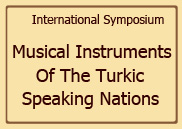
|

